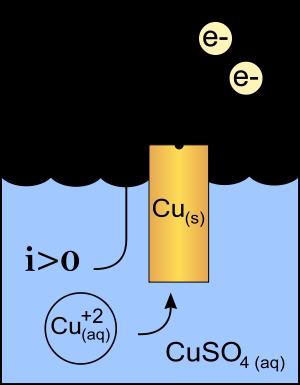A cathode is the electrode from which a conventional current leaves a polarized electrical device. This definition is sometimes remembered using the mnemonic CCD for cathode current departs. A conventional current describes the direction in which positive electronic charges move. Electrons have a negative charge, so the movement of electrons is opposite to the conventional current flow. Consequently, the mnemonic cathode current departs also means that electrons flow into the device's cathode.Cathode polarity with respect to the anode can be positive or negative; it depends on how the device operates. Although positively charged cations always move towards the cathode (hence their name) and negatively charged anions move away from it, cathode polarity depends on the device type, and can even vary according to the operating mode. In a device which consumes power, the cathode is negative, and in a device which provides power, the cathode is positive: In a discharging battery or a galvanic cell, the cathode is the positive terminal since that is where the current flows out of the device (see drawing). This outward current is carried internally by positive ions moving from the electrolyte to the positive cathode (chemical energy is responsible for this "uphill" motion). It is continued externally by electrons moving inwards, this negative charge moving inwards constituting positive current flowing outwards. For example, the Daniell galvanic cell's copper electrode is the positive terminal and the cathode. In a recharging battery, or an electrolytic cell performing electrolysis, the cathode is the negative terminal, from which current exits the device and returns to the external generator. For example, reversing the current direction in a Daniell galvanic cell would produce an electrolytic cell, where the copper electrode is the positive terminal and the anode. In a diode, the cathode is the negative terminal at the pointed end of the arrow symbol, where current flows out of the device. Note: electrode naming for diodes is always based on the direction of the forward current (that of the arrow, in which the current flows "most easily"), even for types such as Zener diodes or solar cells where the current of interest is the reverse current. In vacuum tubes (including cathode ray tubes) it is the negative terminal where electrons enter the device from the external circuit and proceed into the tube's near vacuum, constituting a positive current flowing out of the device.An electrode through which current flows the other way (into the device) is termed an anode.




Comment
0